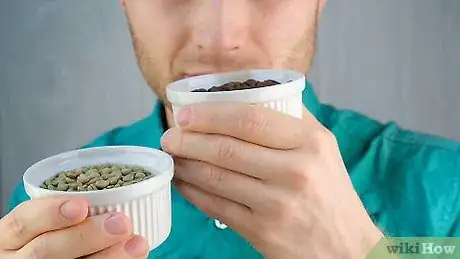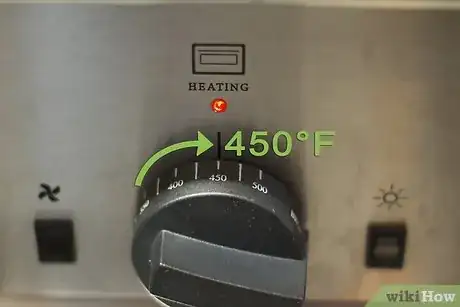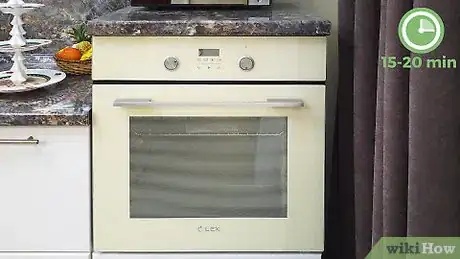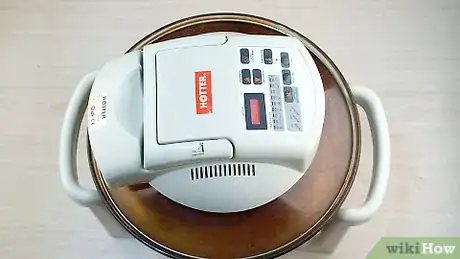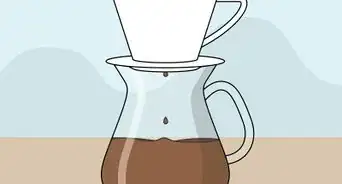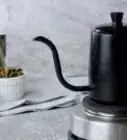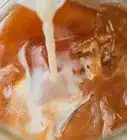wikiHow is a “wiki,” similar to Wikipedia, which means that many of our articles are co-written by multiple authors. To create this article, 60 people, some anonymous, worked to edit and improve it over time.
The wikiHow Video Team also followed the article's instructions and verified that they work.
This article has been viewed 459,732 times.
Learn more...
There is something incredibly satisfying about drinking a cup of coffee made from beans you've roasted yourself. Home-roasted coffee beans are fresher and have flavor complexities not found in store-bought coffee. Scroll down to Step 1 to learn how you can roast your own beans and taste the difference for yourself. Once finished, you can proceed to make coffee.
Steps
Coffee Roasting Basics
Whatever method you choose to use to roast your beans, there are several characteristics of the beans you need to keep in mind when you are roasting them. For the most part, your preferences will determine when you stop roasting the beans.
-
1Keep smell in mind. When you first begin heating your green coffee beans, they will turn a yellowish color and start to emit a grassy smell. When they actually begin to roast, they will start to smoke and smell like true coffee.
-
2Know that the length of your roast is based on the color of the beans. While you will start out with ‘green’ beans, when they begin to roast, your beans will go through a whole array of color. A good rule of thumb is to keep in mind that the darker the bean, the fuller the body of the bean.
- Light brown: This color is generally avoided as it can result in a sour taste. The body is weak, the aroma medium and the sweetness low.
- Light-medium brown: This roast is common in the eastern United States. It has a full body, a full aroma, and a mild sweetness.
- Full medium brown: This is a common roast in the Western United States. It has a full body, strong aroma, and mild sweetness.
- Medium-dark brown: This roast is also known as a Light French or Viennese roast. It has a very full body, a strong aroma, and a strong sweetness.
- Dark brown: This is known as espresso or French. It has a full body, a medium aroma, and a full sweetness.
- Very dark (nearly black): This is also known as Spanish and Dark French. It has a weak body, a mild aroma, and a low sweetness.
Advertisement -
3Listen for the crackling sound. As the beans begin to roast, the water inside them will begin to evaporate, causing a crackling sound to occur. There are generally two stages of crackling called first and second cracking. These two sounds occur as the temperature rises while the roasting occurs.[1]
Using an Oven
Because there is very little air flow, roasting coffee beans in the oven can sometimes lead to a somewhat uneven roast. However, the lack of airflow can also increase the richness of the flavor if the oven is correctly used.
-
1Preheat your oven to 450 °F (232 °C). While your oven is preheating, ready your pan. For this method you will need a baking sheet that has many small holes or slots and a lip that will keep all of the beans in the pan. These pans can be found at any kitchen supply store.[2]
- If you don’t want to buy a new pan but happen to have an old baking sheet with a lip lying around, you can actually make your own roasting sheet. Take your pan and use a ⅛ inch drill bit to carefully drill holes into the sheet. The holes should be ½ inch away from each other and small enough that none of the beans will fall through them.
-
2Lay the beans out on the pan. Pour the beans onto the sheet so that they lie in one layer over the entire pan. The beans should be close together but should not be overlapping. Once the oven is preheated, place the baking sheet with the beans onto the middle rack of the oven.
-
3Roast the beans for 15 to 20 minutes. Listening for a cracking or popping noise. This is the water contained in the beans evaporating. The popping noise signifies that the beans are roasting and darkening. Stir them around every few minutes to help them develop an even roast.[3]
-
4Remove the beans from the oven. When they are roasted to your satisfaction, remove them immediately from the heat. To help them cool down, pour the beans into a metal colander and stir them around. This will help cool the beans as well as remove the chaff.[4]
Using a Popcorn Popper
Roasting your beans on a stove top is best done in an old popcorn popper. The best are crank-style poppers that can generally be found at second hand kitchen supply stores or online. Roasting your beans on the stove top will result in deeper notes and more body but will reduce the aroma and bright notes of the beans.
-
1Place the empty popper onto the stove top. Bring it to a medium heat so that the temperature of the popper is about 450 °F (232 °C). If possible, use a deep fryer or candy thermometer to check the temperature of the popper.
- If you don’t have a popcorn popper and don’t want to buy one, you can use a large skillet or pan. Make sure that it is very clean or else your beans might pick up the flavor of whatever was cooked before them.
-
2Add the coffee beans. You should only roast 8 ounces of coffee beans at a time. Close the lid of the popper and begin turning the crank handle. You will need to continue stirring constantly so that your beans are roasted evenly.[5]
- If you are using a pan or skillet you will need to stir constantly as well--there is much more of a chance for the beans to burn in a skillet or pan.
-
3Listen for the crackling noise. After about four minutes (though it can take up to seven minutes) you should begin to hear a crackling sound--this means that the beans are beginning to roast. At the same time, the beans will start producing coffee-smelling smoke that can be really potent. Turn on your oven hood fan and open a window to let the smoke out. Note the time when the beans start to crackle.[6]
-
4Check the beans’ color frequently. After the crackling starts, wait one minute and then begin to check the color of the beans. When the beans have reached the color you want, pour them out into a metal colander and continue to stir them until the beans cool.
Using an Air Roaster
-
1Consider the pros and cons. Mechanized roasters are a more expensive, yet extremely efficient, roasting option. These appliances work in the same way that the popcorn popper does--hot air is blown across the beans. However, these roasters result in a very even roast.
-
2Consider a hot air roaster. These types of roasters are also called fluid bed roasters. This type of roaster has a glass container that allows you to monitor the color of the beans as they roast, allowing you to roast them to your desired color.[7]
- Roasters of this variety include the FreshRoast8, Hearthware I-Roast 2, and the Nesco Professional. Follow your appliance’s instructions to roast your beans to perfection.
-
3Finished.
Community Q&A
-
QuestionWhere can I find a coffee roaster?
 Community AnswerYou can buy one online or look in your local cafes, as they often have related items for purchase.
Community AnswerYou can buy one online or look in your local cafes, as they often have related items for purchase. -
QuestionI have had a coffee tree for 10 years. This is the second time I've gotten beans from it, but it's only about 10 beans. Can I still roast them and grind for a couple of cups of coffee?
 Community AnswerYes, but you'll only have enough for a very small cup of coffee.
Community AnswerYes, but you'll only have enough for a very small cup of coffee. -
QuestionCan you roast beans that have already been roasted if they were not roasted enough?
 Community AnswerYes, but roast them for the second time in a pan. This is tricky to get to where you want your beans to go, because they darken very quickly. You can definitely hear the crackle sounds from the beans, and you must use a large enough pan to ensure all beans are roasted to the same darkness. The difference in taste is discernable.
Community AnswerYes, but roast them for the second time in a pan. This is tricky to get to where you want your beans to go, because they darken very quickly. You can definitely hear the crackle sounds from the beans, and you must use a large enough pan to ensure all beans are roasted to the same darkness. The difference in taste is discernable.
Things You'll Need
- Green coffee beans
Oven
- Oven
- Perforated pan
- Spatula
- Metal colander
Popcorn Popper
- Popcorn popper
- Candy thermometer
- Metal colander
Air roaster
- Air roaster
- Well-ventilated area
References
- ↑ https://www.cooksillustrated.com/science/847-articles/story/the-science-of-coffee-roasting
- ↑ http://www.sheknows.com/how-to/articles/961051/how-to-oven-roast-your-own-coffee
- ↑ http://www.sheknows.com/how-to/articles/961051/how-to-oven-roast-your-own-coffee
- ↑ https://www.sweetmarias.com/ovenmethod.html
- ↑ https://legacy.sweetmarias.com/library/air-popcorn-popper-method/
- ↑ https://www.cooksillustrated.com/how_tos/6598-roasting-coffee-in-a-popcorn-popper
- ↑ http://www.burmancoffee.com/homeroasting/
About This Article
If you want to roast coffee beans in a pan, pay special attention to the color and smell of the beans. They will start out smelling grassy, but will get a coffee smell as they cook. Once they smell right, start watching the darkness of the beans. Typically, darker beans have more body and a little more sweetness. Take them off the heat when they are roasted to your preference. Keep reading to learn how to roast coffee beans in an oven or an air roaster.
